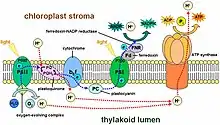Rappephyceae
Rappephyceae, or Rappemonads, are a small family of protists first described in 2011, of uncertain phylogenic affinity.[2] It has been discussed as a possible member of a larger clade Haptophyta.[3] This newly identified taxonomic class of phytoplankton are named after a professor from the Hawai’i institute of marine biology, known as Michael Rappé. Rappé discovered these phytoplankton in the Atlantic Ocean and published his findings on their DNA in 1998.[4] Current research has shown that these organisms provide an immense amount of nutritional organic molecules, such as oxygen, for other organisms using biochemical processes like photosynthesis and carbon fixation.[5]
| Rappephyceae | |
|---|---|
| Scientific classification | |
| Kingdom: | Chromista |
| Phylum: | Haptista |
| Subphylum: | Haptophytina |
| Class: | Rappephyceae M. Kawachi, R. Kamikawa & T. Nakayama, 2021[1] |
| Orders | |
| |
Classification
Haptophytes, are the type of clade in which Rappephyceae fall under.[6] The Haptophyte clade comprises around 500 marine algal species.[7] One of the most novel characteristics of Haptophytes is their calcite, or calcium carbonate, scales that cover the cell; These cells are also known as coccoliths and the whole organism can be referred to as a Coccoliphore. Coccolithophores are responsible for approximately 50% of the calcium carbonate precipitation in oceans.[8] While Rappephyceae are a newly classified group, they are likely to share many evolutionary properties with other Coccolithophores. Rappephyceae earn their own class from their unique morphology.[5] This class of phytoplankton have been described to represent a plastid-bearing protistan lineage. This has been identified using molecular sequencing techniques with the environmental plastid 16s rRNA obtained from Rappephyceae.[5] Using current DNA libraries, the authors of this article concluded that these species are closely related to Gephyrocapsa huxleyi and Prymnesium parvum which are both classified as primary producers. It is reasonable to assume that this class of phytoplankton significantly contributes to the ecosystem.
Biological properties
As members of the Haptophyte clade, Rappephyceae are considered autotrophs. Similar to plants, phytoplankton contain chlorophyl in their cells which act to capture sunlight, carbon dioxide, and water; These molecules are converted from light energy to chemical energy creating essential biomolecules like oxygen and glucose. Since phytoplankton have no use for the oxygen molecules, they are released and acquired by more complex organisms. This process is often referred to as Photosynthesis, or the light cycle as it occurs in the presence of sunlight. This characteristic give Rappephyceae the title of primary producers.

Since Rappephyceae are considered Cocclithophores, they can act as microfossils giving insight into previous ecological conditions.[8]
References
- Kawachi, Masanobu; Nakayama, Takuro; Kayama, Motoki; Nomura, Mami; Miyashita, Hideaki; Bojo, Othman; Rhodes, Lesley; Sym, Stuart; Pienaar, Richard N.; Probert, Ian; Inouye, Isao; Kamikawa, Ryoma (June 2021). "Rappemonads are haptophyte phytoplankton" (PDF). Current Biology. 31 (11): 2395–2403.e4. doi:10.1016/j.cub.2021.03.012. PMID 33773100. S2CID 232369943.
- Kim, Eunsoo; Harrison, James W.; Sudek, Sebastian; Jones, Meredith D. M.; Wilcox, Heather M.; Richards, Thomas A.; Worden, Alexandra Z.; Archibald, John M. (25 January 2011). "Newly identified and diverse plastid-bearing branch on the eukaryotic tree of life". Proceedings of the National Academy of Sciences of the United States of America. 108 (4): 1496–1500. doi:10.1073/pnas.1013337108. PMC 3029697. PMID 21205890.
- Cavalier-Smith, Thomas; Chao, Ema E.; Lewis, Rhodri (December 2015). "Multiple origins of Heliozoa from flagellate ancestors: New cryptist subphylum Corbihelia, superclass Corbistoma, and monophyly of Haptista, Cryptista, Hacrobia and Chromista". Molecular Phylogenetics and Evolution. 93: 331–362. doi:10.1016/j.ympev.2015.07.004. PMID 26234272.
- "New class of marine phytoplankton named for UH professor" (Press release). University of Hawaiʻi. 22 April 2021. ProQuest 2516733806.
- Kawachi, Masanobu; Nakayama, Takuro; Kayama, Motoki; Nomura, Mami; Miyashita, Hideaki; Bojo, Othman; Rhodes, Lesley; Sym, Stuart; Pienaar, Richard N.; Probert, Ian; Inouye, Isao; Kamikawa, Ryoma (June 2021). "Rappemonads are haptophyte phytoplankton" (PDF). Current Biology. 31 (11): 2395–2403.e4. doi:10.1016/j.cub.2021.03.012. PMID 33773100. S2CID 232369943.
- Kawachi, Masanobu; Nakayama, Takuro; Kayama, Motoki; Nomura, Mami; Miyashita, Hideaki; Bojo, Othman; Rhodes, Lesley; Sym, Stuart; Pienaar, Richard N.; Probert, Ian; Inouye, Isao (2021-06-07). "Rappemonads are haptophyte phytoplankton". Current Biology. 31 (11): 2395–2403.e4. doi:10.1016/j.cub.2021.03.012. ISSN 0960-9822. PMID 33773100.
- van den Hoek, Christiaan; Mann, David; Jahns, H. M. (1995). Algae: An Introduction to Phycology. Cambridge University Press. p. 226. ISBN 978-0-521-31687-3.
- Reyes-Prieto, A.; Yoon, H.S.; Bhattacharya, D. (2009). "Marine Algal Genomics and Evolution". Encyclopedia of Ocean Sciences. pp. 552–559. doi:10.1016/B978-012374473-9.00779-7. ISBN 978-0-12-374473-9.
Further reading
- Rappé, Michael S.; Suzuki, Marcelino T.; Vergin, Kevin L.; Giovannoni, Stephen J. (January 1998). "Phylogenetic Diversity of Ultraplankton Plastid Small-Subunit rRNA Genes Recovered in Environmental Nucleic Acid Samples from the Pacific and Atlantic Coasts of the United States". Applied and Environmental Microbiology. 64 (1): 294–303. Bibcode:1998ApEnM..64..294R. doi:10.1128/AEM.64.1.294-303.1998. PMC 124708. PMID 9435081.